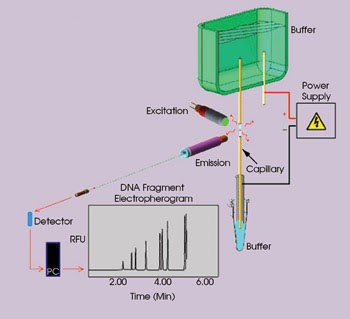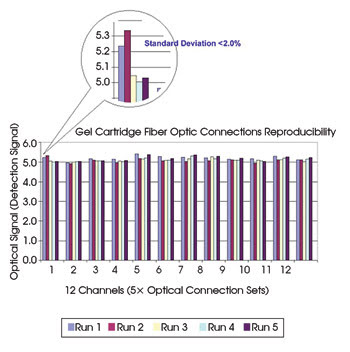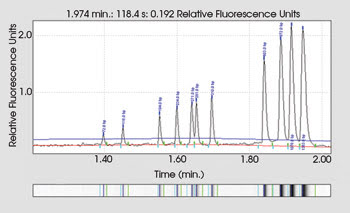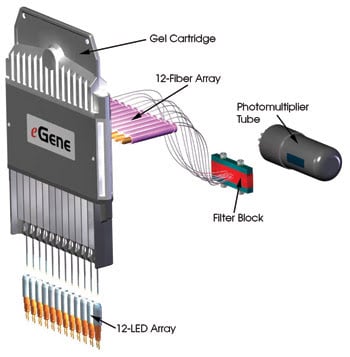Fiber optics helps simplify DNA analysis.
Varouj D. Amirkhanian, Karl Cabrera, Dave Anderson and Dr. Ming-Sun Liu, eGene Inc.
Since the completion of the Human Genome Project, more than 30,000 genes involved in the function of the body have been found in a single human cell. The information attained from genetic (DNA) analysis has the potential to revolutionize the diagnosis, prevention and treatment of human diseases.
Genetic analysis is used for identifying drug-resistant strains, for infectious disease testing applications in bioterrorism, for disease diagnostics and prognostics (cancer, cardiovascular, Alzheimer’s), for the diagnosis of inherited disorders, for molecular tissue pathology, for forensic identity/testing and for pharmacogenetics (therapy selection, monitoring, adverse).
Most DNA fragment analysis used in laboratories is performed using slab gel-based electrophoresis, which has been routinely used since its inception more than 20 years ago. However, using slab gel electrophoresis for DNA analysis is labor-intensive and does not exhibit high resolving power or throughput.
Capillary electrophoresis is a microfluidic approach to electrophoresis, whose greatest advantage is its diverse range of applications. This technology is commonly accepted by the biotechnology industry as a reliable, high-resolution and highly sensitive detection tool for nucleic acid-based testing.1
Capillary electrophoresis with laser-induced fluorescence is one of the most powerful analytical tools for rapid, high-sensitivity and high-resolution nucleic acid-based analysis and testing.2 However, multichannel systems using this technology contain complicated scanning optical detection mechanisms and thus are much more expensive than traditional slab gel-based DNA analysis systems, and they are out of reach for all but a few well-funded laboratories.
Lower-cost DNA analysis
To fulfill the need for a technology that is sensitive, specific, high-throughput and cost-effective, eGene Inc. has developed a 12-channel capillary electrophoresis instrument for DNA/RNA analyses. Ultimately, it might provide standardization for routine genetic analysis.

Figure 1. The system uses multiplexed fluorescence detection to perform microcapillary-basedgel electrophoresis. RFU = relative fluorescence units.
The HDA-GT12 system is based on a patented multiplexed fluorescence detection design using microcapillary-based gel electrophoresis technology and a reusable gel cartridge. A multifiber optic connection couples incident radiation from an LED source to an array of 12 optical fibers, which excite the separated analytes for emission detection in the capillary tubes (Figure 1).3,4
As the DNA fragments move through the sieving gel, or linear polymer solution, a DNA intercalating dye within the sieving gel enables the detection of migrating DNA fragments (Figure 3). Experiments have shown that detection sensitivities of 100 ng/ml are achievable, which is several orders of magnitude better than those of conventional slab gel electrophoresis devices using the same intercalating dye.

Figure 2. The optical coupling efficiency of the cartridge translates to the reproducibility of the fiber connections for each of the 12 channels of the cartridge shown here.
Twelve excitation LEDs are time-multiplexed (with a sampling frequency of 10 to 100 Hz), producing multiplexed signals to the 12 separation microchannels (capillary tubes); proportionally, 12 time-staggered emitted fluorescence signals are collected by 12 microball lenses, each coupled to an emission detection optical fiber that relays the signal to a single photomultiplier tube. Simplifying the optical detection system using fiber optics and micro-optics reduces the overall manufacturing cost while also improving the reliability of the instrument.
The gel cartridge supports 12 fused silica capillaries for capillary electrophoresis separation (Figure 4) and has a reservoir that contains a separation support medium (for example, a gel matrix buffer) that is common to all capillaries.
The chemistry of the medium and the characteristics of the capillaries (e.g., capillary size, coating and length) are defined for each cartridge. Different cartridges can be easily interchanged in the system to suit a particular sample analysis.

Figure 3. This close-up view of an electropherogram shows that 72 to 1353 base pair separations occurred in less than 2 min when phiX174 Hae III dsDNA fragments were analyzed in the 12-capillary gel cartridge (GC-HLA SSP gel cartridge).
The short and narrow bore capillaries combined with the special integrated gel matrix provide a low operating current (<200 μA) at high applied voltages (up to 10 KV) without the need to cool the capillaries, which allows high-speed, high-resolution separations or results.
The system provides large-volume and low-cost DNA screening that can be used in molecular diagnostics for applications such as detection of human leukocyte antigen, HIV, hepatitis B virus, hepatitis C virus and human papillomavirus, and it can be used for pharmacogenomics, for food analysis and for other applications.

Figure 4. The 12-channel disposable gel cartridge with 12-fiber optic-based detection interface is shown.
Even though the chemistry cost per test is less than half that of slab gel systems, the system produces detection sensitivity and high resolution found only in high-end capillary electrophoresis systems (the larger and costly sequencing-type instruments).
The system can reduce DNA separation time from three to four hours with slab gel methods to less than 10 min; can reduce labor and consumables (reducing the possibility of human error by eliminating manual intervention, and reducing testing materials such as gel, buffer, dye and DNA markers by 50 percent); achieve a sensitivity of 1 pg/μl to 0.1 ng/μl and a resolution of less than 5 base pairs; and reduce biohazardous waste. It also can perform reproducible quantitative DNA/RNA analysis, especially for PCR-amplified DNA products.
These benefits make the automatic genotyping system a good alternative to messy, labor-intensive slab gel and to high-cost, high-end capillary electrophoresis-type systems. The system is ideal for the molecular diagnostics industry, which demands sustained and stable recurring revenue from a base of installed instruments and from testing reagents.
Meet the authors
Varouj D. Amirkhanian is director, development and operations analytical systems at eGene Inc. in Irvine, Calif., now a Qiagen company; e-mail: [email protected].
Karl Cabrera is production manager, Dave Anderson is senior mechanical engineer, and Ming-Sun Liu is executive director and general manager at eGene Inc.
References
1. A. Guttman and N. Cook (1991). Capillary gel affinity electrophoresis of DNA fragments, ANAL CHEM, Vol. 63, pp. 2038-2042.
2. H.E. Schwartz and K.J. Ulfelder (1992). Capillary electrophoresis with laser-induced fluorescence detection of PCR fragments using thiazole orange. ANAL CHEM, Vol. 64, pp. 1737-1740.
3. V.D. Amirkhanian and M.-S. Liu (2002). Low-cost and high-throughput multichannel capillary electrophoresis (MCCE) system for DNA analysis, biomedical nanotechnology architectures and applications. Proceedings of SPIE, Vol. 4626, pp. 238-245.
4. M.-S. Liu and V.D. Amirkhanian (2003). DNA fragment analysis by an affordable multiple-channel capillary electrophoresis system. Electrophoresis, Vol. 24, pp. 93-95.